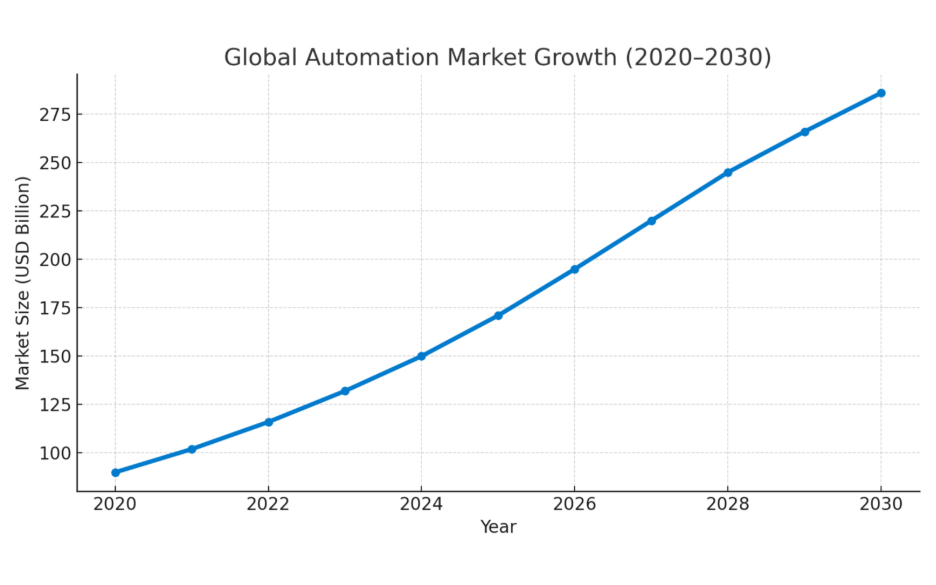Automation & Intelligent Workflows
Streamlining Operations Through AI, Orchestration, and Data-Driven Precision
At Sense & Respond Software, we help organizations unlock agility and efficiency through AI-powered automation and intelligent workflows that adapt in real time. Our solutions don’t just automate repetitive tasks — they sense business conditions, make data-driven decisions, and respond proactively.
The Global Automation Landscape (2024–2025)
Automation has evolved from simple rule-based scripting into enterprise-scale AI ecosystems driving transformation across industries.
Market Growth
Enterprise Adop
RPA to AI Shift
AI & Human
ROI Metrics
The rise of hyperautomation, intelligent process automation (IPA), and AI orchestration is reshaping how businesses operate, scale, and compete.
Key Data Visuals
Global Automation Market Growth (2020–2030)

Intelligent Workflow Adoption by Region (2025)
Automation Adoption by Industry (2025)
Automation ROI Metrics (2024)
Our Experience-First Approach
Designing Intelligent Workflows That Empower People
Automation must begin with understanding the human journey.
We analyze how people work, where friction exists, and what decisions require judgment — then design intelligent workflows that augment human capability rather than replace it.
We blend process design, machine learning, orchestration platforms, and integration engineering to automate at scale — without losing agility or control.
1. Process Discovery and Design
We start with process intelligence — mapping business activities, dependencies, and inefficiencies.
Our consultants conduct workshops with business stakeholders and technical teams to identify quick wins and high-impact automation opportunities.
We use process mining tools (Celonis, UiPath Process Mining, Power Automate Insights) to visualize real process flows, detect bottlenecks, and design automation blueprints grounded in data, not assumptions.
Our engineering teams design these workflows to be event-driven, secure, observable, and scalable, capable of handling millions of automated transactions across cloud and on-prem environments.
2. Intelligent Orchestration and Engineering
We deploy automation as composable systems — not static scripts — ensuring agility and adaptability.
Our orchestration architecture includes:
- AI-powered RPA: UiPath, Automation Anywhere, and Power Automate for task automation.
- Workflow Engines: Camunda, Airflow, Temporal for dynamic process orchestration.
- Decision Engines: Drools, AWS Step Functions, Azure Logic Apps for real-time logic.
- Integration Layer: REST/GraphQL APIs, Kafka streams, webhooks for cross-system flow.
- AI Components: ML models embedded for anomaly detection, approvals, and predictions.
3. Continuous Optimization (Sense & Respond Loop)
Automation is never “done.” It’s an evolving capability that must continuously sense operational data, analyze it, and respond by adapting workflows dynamically.
At Sense & Respond, we embed an AI-driven optimization layer that monitors process health, exception patterns, and user interactions in real time.
Our approach ensures every automation initiative delivers increasing returns over time.
Key components include:
- Continuous feedback loops with telemetry and audit data.
- Predictive analytics for identifying process drift.
- Self-healing automations that resolve exceptions without human intervention.
- AI-driven recommendations for process redesign.
- Business KPIs linked directly to automation triggers and decisions.
This approach ensures that automation remains adaptive, transparent, and business-aligned — delivering compounding value as it matures.
Global Perspective
India
- India is the global hub for automation delivery, with Bengaluru, Pune, and Hyderabad leading intelligent workflow innovation.
- Over 35% of the world’s RPA professionals are based in India.
- Local industries — BFSI, Telecom, and Manufacturing — are driving hyperautomation initiatives integrating AI and IoT.
United States
- The U.S. leads global investment in intelligent automation platforms, contributing 40% of worldwide spending.
- California, Texas, and New York dominate enterprise adoption across finance, healthcare, and logistics.
- U.S. firms are rapidly moving toward autonomous business operations, blending process mining, RPA, and generative AI for decision-making.
Automation That Works
Focused on the right processes, guided by AI, and built to evolve over time.
Best Practices: What Works Consistently
Over the years, we’ve learned that successful automation is a balance of design thinking, governance, and intelligent technology orchestration. At Sense & Respond, our automation philosophy is guided by several key best practices:
Process Understanding
We begin with process understanding, not tool selection — mapping how teams work before introducing automation tools. By grounding automation in real user behavior and business data, we ensure it targets the right pain points.
Apply AI Augmentation
We apply AI augmentation instead of total automation, allowing digital workers to complement humans in areas where creativity and judgment are still required.
Governed Automation
Every deployment follows a governed automation framework — covering change control, exception management, and compliance validation.
Security Concern
Security is treated as non-negotiable: all workflows use secure tokens, encrypted logs, and audit trails to ensure accountability.
Resilience & Transparency
We design automations for resilience and transparency, building visibility into every transaction via observability dashboards.
Measure What Matters
Finally, we measure what matters — time saved, error reduction, compliance accuracy, and satisfaction scores — aligning automation performance directly with business outcomes.
The Result:
These practices help clients move from automation projects to automation ecosystems — living systems that continuously sense, learn and respond.
Lessons Learned: What Not to Do
Automation can create incredible value — or incredible complexity — depending on how it’s implemented. From our global delivery experience, we’ve seen common pitfalls that derail automation success, and we’ve learned how to prevent them.
Automating Chaos
Building bots over broken or undocumented processes. Without standardization, automation magnifies inefficiency.
First Thinking
Choosing platforms before understanding needs. Technology is not strategy; design and governance must come first.
Smart Observability
We’ve seen teams fail by over-automating human judgment, replacing decisions that require nuance with rigid workflows that alienate users.
Neglecting Security
Neglecting security and compliance is another major risk. Many automation frameworks inadvertently expose data through poorly secured credentials, logs, or APIs.
Change Management
Organizations also struggle when they ignore change management — failing to prepare employees for new roles in a hybrid human–digital workforce.
No Feedback Loop
Finally, no feedback loops lead to automation stagnation — systems that stop improving because they’re never measured.
The Result:
At Sense & Respond, we treat automation as a journey, not a milestone. Creating automations that adapt as fast as the businesses they serve.